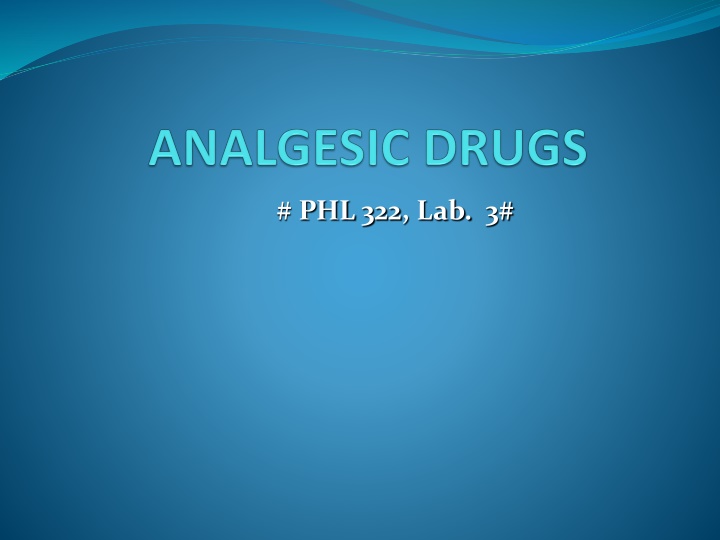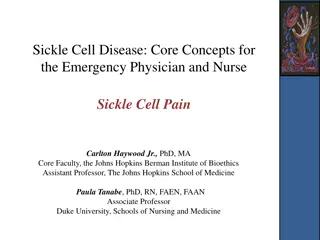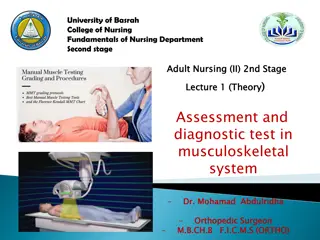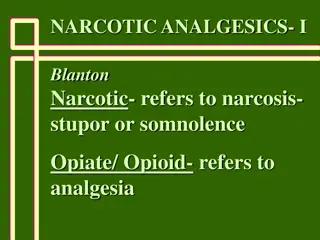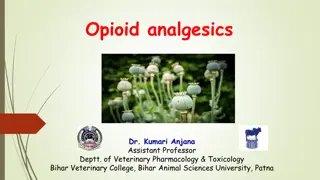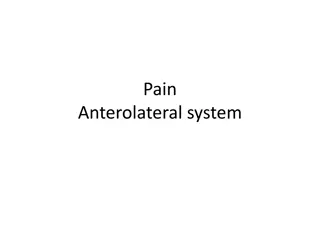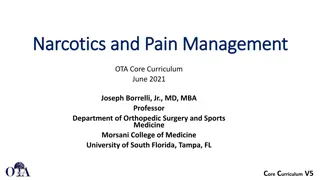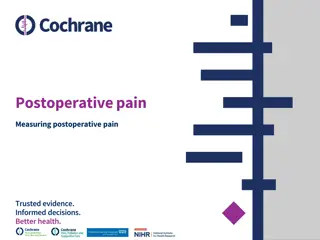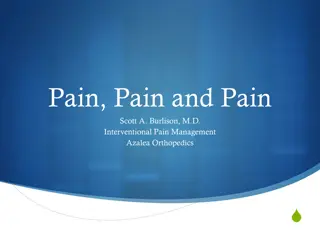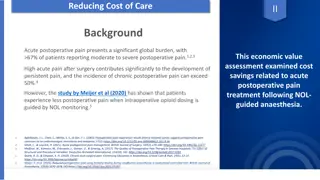Pain and Analgesics in Medical Science
Pain is a complex sensory and emotional experience linked to tissue damage, with various types of nerve fibers and nociceptors playing key roles in its perception. Pain mediators like bradykinin and prostaglandins modulate sensitivity to pain stimuli. Analgesics, including non-opioid NSAIDs and opioid drugs like morphine, aim to alleviate or suppress pain by targeting different pathways in the body.
Download Presentation

Please find below an Image/Link to download the presentation.
The content on the website is provided AS IS for your information and personal use only. It may not be sold, licensed, or shared on other websites without obtaining consent from the author.If you encounter any issues during the download, it is possible that the publisher has removed the file from their server.
You are allowed to download the files provided on this website for personal or commercial use, subject to the condition that they are used lawfully. All files are the property of their respective owners.
The content on the website is provided AS IS for your information and personal use only. It may not be sold, licensed, or shared on other websites without obtaining consent from the author.
E N D
Presentation Transcript
Introduction - Pain: an unpleasant sensory and emotional experience associated with actual or potential tissue damage, or described in terms of such damage - Analgesics : Drugs used to relief or suppress the pain.
pain is associated with electrical activity in small diameter primary afferent fibers of peripheral nerves . These nerves have sensory ending in the peripheral tissues and activated by noxious stimuli of various kinds : Chemical stimuli I. II. Thermal stimuli III. Mechanical stimuli
Types of afferent sensory nerve fibers : C- fibers A - fibers Non- myelinated Myelinated Low conducting velocity High conduction velocity Cause a dull burning and non-localized pain Cause a sharp and localized pain
Nociceptors A Sensory receptor that sends signals that cause the perception of pain in response to a potentially damaging stimulus. These receptors are activated by mechanical, thermal and chemical stimulants. Provide information about the location, intensity and duration of a noxious stimulus to the body Nociceptors are connected to primary afferent nerve fibers.
Pain Mediators pain mediators include : bradykinin, leukotriene, substance P, histamine, Ach, 5-HT and prostaglandins they increase the sensitivity of the nerve ending to other pain mediators
Pain Mediators Mechanism of action of the paim mediators to cause pain : Direct : stimulate of the nerve ending directly via nocieceptors. I. II. Indirect : increase the sensitivity of nerve ending to other pain mediators.
Analgesics are divided into Non- narcotic analgesics ( non- opioid analgesics ) ( non- steroidal anti-inflammatory drugs ) NSAIDs Narcortic analgesics ( opioid analgesics ) e.g. Morphine e.g. Aspirin
Opioid analgesics Opioid include natural (Morphine), semisynthetic (Heroin) and synthetic (Fentanyl). They reduce moderate to severe pain without loss of consciousness. They act by binding to specific receptors located primarily in the brain and spinal cord.
Opioid analgesics The major classes of opioid receptors are( , , ) mu, delta and kappa. Each receptor type has subtypes: mu1, mu2, delta1, delta2, kappa1, kappa2 and kappa3. Most of the currently available opioid analgesics act primarily at the mu receptor.
Mechansimof action : All opioid recptors are linked through G-proiten by inhibition of adenylate cyclase i.e facilitate opening of K channels ( causing hyperpolarization ) and inhibit opening of Ca channels ( inhibiting transmitters release ) They stimulate the release of endogenous opioid peptide ( endorphins and enkephalins) which cause decresing in release of pain mediators.
Side effects: Dependency and tolerance Nausea and constipation CNS: drowsiness, lightheadedness, euphoria or dysphoria, or confusion. Urinary retention Respiratory depression, particularly in elderly or debilitated patients Miosis ( constriction of the pupil )
Non opioid analgesics (NSAIDs) Aspirin and other NSAIDs are useful for the treatment of pain from injury ( mild to moderate ) Examples for NSAIDs : Cox ( cyclooxygenase) non selective : Aspirin, I. Ibuprofen, Diclofenac etc II. Cox2 selective : Celecoxiband Rofecoxib.
Phospholipids Phospholipase A2 Arachidonic Acid COX Lipoxygenase Prostaglandins Leukotrienes Thromboxanes Prostacyclin
LAB WORK Objective : To show the analgesic effects of different analgesics using different methods. Writhing test. I. II. Hot plate method.
Writhing test Principle: Pain is induced by injection of noxious chemical as Acetic acid 0.1% at volume 0.3 ml. Writhing means stretching behavior of the abdominal and at least one hind limb.
Procedure: 1.First inject the mouse with acetic acid and calculate the number of writhing/20 minutes and this will be control test. 2.Inject the second animal with aspirin and inject the third one with morphine. 3.After 5 minutes inject the animals with acetic acid then calculate the number of writhing/20 minutes.
Procedure: 4.Compare the number of writhing for each drug and comment on the results (a drug has less number of writhing >>> more potency as analgesic.
No. of writhing/20 minutes Drug Control Acetic cid Test 1 Morphine acetic acid 5 min s 5 min s Test 2 Aspirin acetic acid
Hot plate method principle: The paws of the mouse are very sensitive to heat at temperature which are not damaging the skin . At temperature of 55 C the mouse will jump and licking the paws. The time till these response occur is calculated and is prolonged after administration of analgesics.
Procedure: Put the mouse on the hot plate and record the time taken in 1. order to jump or licking the fore paws. Record the time in seconds this is the control time. 2. Weight the animal and calculate the dose of Morphine and 3. Aspirin At 5 min s interval ( for 30 min s ) place the animal on the hot 4. plate and record the time to see the response . Compare the time need to see the response the drug with 5. longer time is more potent as analgesic.
Time interval 15 Drug zero 5 10 20 25 30 Morphine aspirin
Dose mg/Kg Conc (g%) Morphine 0.2% 20 aspirin 3% 300
